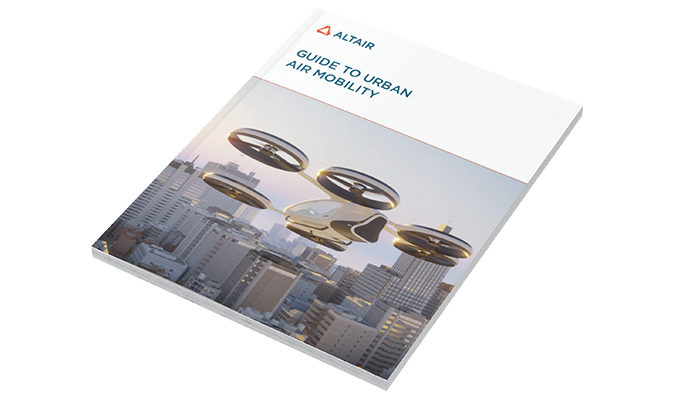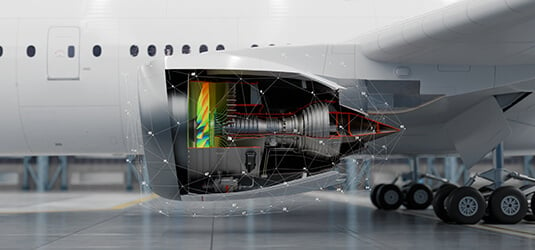
Aerospace
Driven by a quest for more sustainable aviation, advanced air mobility vehicles, cheaper and easier access to space, challenging geopolitical conditions, talent shortages, and the rapid evolution of technology, the aerospace industry is experiencing a wave of innovation that’s bringing new players into the sector. Initiatives like the digitalization of engineering, smart factories, certification by analysis, digital maintenance repair and overhaul (MRO), digital twins, and artificial intelligence (AI) are now essential to deal with the complexity of aerospace asset life cycles and ensure aerospace companies’ competitiveness.
Altair is the only company in the market with a deep understanding of engineering, design, production, and data analytics. We deliver open solutions powered by the convergence of data analytics, the Internet of Things (IoT), and digital twins, energized by high performance computing (HPC), and machine learning.
We help aerospace companies involved in defense, civilian aviation, and space technology navigate the evolving digital landscape, build solutions at speed, and scale them across the organization. We empower companies to make data-driven decisions and deliver programs on time and at cost, while creating a safer, more connected, and more sustainable future.
Sustainable Aviation
The aerospace industry is working towards greener, quieter, and more efficient aircraft, better production processes to meet ambitious emissions reduction targets, and compliance with increasingly stringent regulations. Altair enables all organizations to leverage the power of AI, data analytics, and simulation to make your products, factories, and operations more sustainable.
Improve Engineering Efficiency
The industry’s new challenges and technologies create a skills gap in many organizations. At the same time, too many experienced engineers are retiring. Altair’s solutions boost your team’s capabilities and facilitate fast, effortless reskilling. Our tools leverage AI to automate processes and capture knowledge, allowing your people to make informed, data-driven decisions, create collaborative and interoperable environments, and achieve more — even with resource constraints.
AI-Enabled Smart Factories
Orders for new, more efficient aircraft are exceeding the production capacity of OEMs, while startups push ahead with plans to build assets such as e-VTOLs, SmallSats, and launchers in bulk. The traditional supply chain is also at risk due to ever-changing geopolitical tensions. Altair’s technology helps organizations monitor and optimize production plants – including their operations, maintenance, spare parts, and supply chain – even in unpredictable environments. Altair boosts productivity, minimizes costs, and increases manufacturing plant flexibility.
How can we help you design for the future of aerospace?
Contact Us
Enhance Connectivity
Within aerospace, the ability to transmit and receive information is paramount. People and equipment must have reliable, robust, and always-on systems that exchange data at high speed. Predicting how these systems will perform in changing weather conditions, over different terrain morphologies, and/or with interference is a complex task.
Altair’s AI-powered solutions enable your team to optimize the entire communications system, including electronics, antennas, cables, energy sources, radomes, ground stations, and beyond. Our tools can handle very large radio frequency and electronic domains. Overall, users can maximize their systems’ reliability and range while reducing dimensions, weight, and energy consumption.

Design, Test, and Certify Advanced Air Mobility Vehicles
The convergence of technological innovation and urbanization is reshaping the landscape of air mobility. From unmanned vehicles to e-VTOLs, industry leaders must use new materials, implement new propulsion systems, incorporate batteries, reduce noise, build novel infrastructure, and demonstrate the safety required for both certification and public acceptance.
Altair’s simulation and data analytics solutions enable fast exploration and validation of design concepts. Our tools enable digital performance and safety testing of airframes, motors, avionics, and batteries, speeding up certification and supporting shorter go-to-market cycles.

Optimizing MRO and Supply Chain with AI
Commercial, military, and private aerospace enterprises must keep aircraft and components safe, operational, and compliant with regulations. Altair’s maintenance, repair, and overhaul (MRO) solutions leverage AI-driven analytics to extend aircraft lifespan, optimize performance, and address wear and tear, system failures, and upgrades. By optimizing inventory, reducing stock-related risks, and improving order planning, organizations can ensure critical assets are available when needed. Real-time performance tracking monitors key metrics such as turnaround time, on-time delivery, and warranty claims, ensuring safety, efficiency, and cost management.
Aerospace startups: Learn how our dedicated acceleration program can reduce your costs.
Learn More
Enabling the New Space Economy
From fuel efficient, lighter, and reusable rockets to small satellites built with COTS components, the space industry has transformed. No longer the domain of a few government agencies, space is now a resource open to organizations of nearly any size. Launch slots are widely available, and the cost of putting sensors into orbit has become affordable. The challenge now is to push these boundaries further by increasing production rates, sensor capacity, data transmission rates, and analysis capabilities.
Altair helps users test new designs, materials, and production technologies that reduce weight, size, and energy consumption and make products that survive the harsh conditions of launch, orbit, and landing — or even operate on the surface of a distant celestial body.

High-Performance Computing for Aerospace
Organizations including NASA, Boeing, and more have long depended on Altair® HPCWorks®, our HPC and cloud platform, for robust, efficient workload management and more. Altair’s tools are built for a broad spectrum of HPC and cloud workloads plus efficient, high-throughput computing for EDA applications — and trusted to manage, optimize, and measure mission-critical aerospace workloads. Lives depend on quality and precision throughout products’ design, development, and manufacturing; HPC supports some of the most important projects on (and off) the planet and keeps them running at maximum efficiency.
Key Use Cases
- Reduce weight with design optimization, weight and cost analytics, and new materials.
- Revolutionize propulsion by making traditional engines more efficient, design and integrate electric or hybrid systems, and design and build safer batteries and fuel cells.
- Reduce drag with CFD analysis, optimization, and digital twins.
- Reduce energy consumption and manage waste through process analysis, IoT, and digital twins.
- Create digital twins that combine simulation, historical data, and input form sensors. Monitor, analyze, and optimize the real-world performance of your designs in real time.
- Reskill your team to keep up with technology and maximize your digital initiatives with our learning academy and engineering services.
- Avoid unplanned downtime through predictive and prescriptive maintenance.
- Gain operational insights and optimize shop floor efficiency by identifying hidden anomalies.
- Monitor connected assets and retrieve and use data more effectively by implementing IoT.
- Optimize production processes through simulation and AI to reduce scrap rates and improve quality.
- Reduce MRO costs with text analytics and digital twins of your electrical systems’ schematics.
Featured Resources

Rolls Royce: Convergence of Engineering and Data Science
The traditional engineering processes ensure that safe and robust products are being developed. However, the growing demand for innovative solutions in short time scales drives the need for a cultural change in the way we work in engineering. Looking at the traditional product life cycle we see that important design decisions tend to be made early during the concept design phase before detailed analysis or test data are available. Data analysis techniques in combination with classical engineering tools can practically help to resolve that conflict by making more useful information available earlier in the process. Consequently the entire process can become more effective.

Building Reliable Space Products 10x Faster - Altair SimSolid Streamlines Product Development Cycles for Rocket Launch Systems
When it comes to manufacturing innovative aerospace technologies, the product development and analysis process can be long and tedious. As part of their new generation launch vehicle and spacecraft engine product offerings, Astra was looking for a way to streamline their product development life cycle. While they intended to improve speed and efficiency, it was important that Astra’s team not lose accuracy within their data and remain consistent with their pre-existing test results. With Altair SimSolid, Astra was able to build and analyze better, more reliable products faster. It allowed Astra to perform the expected workload they needed, producing robust results and accurate reporting in a tenth of the time it took other in-house tools currently in use.

Fly High with Optimization - Optimizing Camcopter® S-100 Design at Schiebel
Unmanned aerial systems (UAS) are a rapidly evolving technology and used for a variety of civil and military purposes. To ensure airworthiness, UAS manufacturers rely on advanced simulation and manufacturing techniques to create efficient designs. Aerial systems active throughout Europe and operating with diverse payloads for different missions require a reliable vehicle architecture and fuel supply. To ensure perfectly tuned architecture and a lightweight design while increasing stiffness and strength, Schiebel used Altair solutions in combination with 3D printing. The engineers performed various simulations to optimize the design of AM engine parts. Using Altair’s topology optimization structural design tool, Schiebel reduced the weight significantly while maintaining high stiffness. Subsequently, the system was evaluated by laminar and turbulent flow simulation as well as conjugate heat transfer simulation using Altair CFD™. Contacts, NLFE and complex dynamic systems were modeled with Altair® MotionView® and Altair® MotionSolve®. Schiebel also took advantage of APA solutions.






